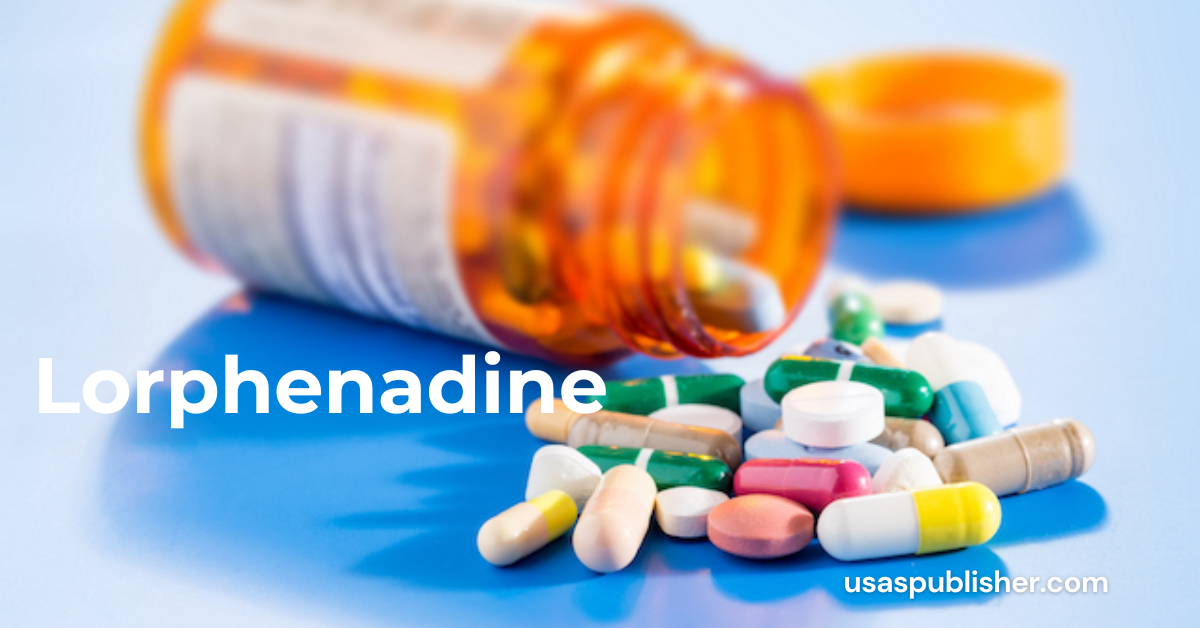Lorphenadine, an antihistamine medication, has been widely used for decades to treat various allergic reactions, hives, and insomnia. Despite its popularity, many individuals are unaware of its history, chemical structure, and proper usage.
In this comprehensive article, we will delve into the world of Lorphenadine, exploring its benefits, medical uses, recommended dosages, side effects, and more. Our goal is to provide you with a thorough understanding of this medication, enabling you to make informed decisions about its use.
What is Lorphenadine?
Lorphenadine is an over-the-counter (OTC) antihistamine medication available in various forms, including tablets, capsules, and syrups. It belongs to the diphenylmethylpiperazine class of antihistamines, which work by blocking histamine receptors in the body.
Lorphenadine is known for its sedating effects, making it a popular choice for treating insomnia and other sleep disorders.
History of Lorphenadine
Lorphenadine was first synthesized in the 1980s by a team of scientists at the pharmaceutical company, Schering-Plough (now part of Merck & Co.). Initially, it was developed to treat allergic rhinitis, but its sedating properties soon made it a popular choice for insomnia treatment.
Also Read:What is 127.0.0.1:62893 – Know Its Importance In 2024
Lorphenadine was approved by the US Food and Drug Administration (FDA) in 1993 and has since become a widely used medication.
Chemical Structure and Properties
Lorphenadine’s chemical structure consists of a phenyl ring attached to a piperidine ring, with a molecular formula of C17H19NO and a molecular weight of 257.34 g/mol. It appears as a white or off-white crystalline powder with a melting point of 125-130°C.
Lorphenadine is soluble in water, ethanol, and chloroform, and its pharmacokinetic properties include a bioavailability of 70-80% and a half-life of 10-12 hours. It is metabolized by the liver enzyme CYP2D6 and excreted primarily in the urine.
Lorphenadine’s chemical structure and properties contribute to its antihistaminic and sedative effects, making it a useful medication for treating allergies, insomnia, and other conditions.
How Lorphenadine Works in the Body
Lorphenadine works by binding to histamine receptors in the body, specifically the H1 receptor subtype. This binding action blocks the effects of histamine, a chemical released by the body’s immune system during an allergic reaction.
By antagonizing histamine, lorphenadine reduces the symptoms of allergies, such as itching, hives, and swelling. Additionally, lorphenadine’s sedative properties are attributed to its ability to cross the blood-brain barrier, where it interacts with the central nervous system, leading to a decrease in the activity of the neurotransmitter acetylcholine, resulting in a calming effect and drowsiness.
Also Read: Netwyman Blogs – Features, Why Choose In 2024
Overall, lorphenadine’s mechanism of action provides relief from allergic symptoms and promotes relaxation, making it an effective medication for various conditions.
Benefits of Lorphenadine
Rapid Onset of Action
Lorphenadine’s rapid onset of action is one of its significant benefits, providing quick relief from allergic symptoms and insomnia. Unlike some other antihistamines that may take hours to start working, lorphenadine begins to take effect within 30 minutes to 1 hour after administration, making it an ideal choice for sudden allergic reactions or when sleep is urgently needed.
Long-Lasting Effects
Lorphenadine’s effects last for an extended period, typically 12-24 hours, depending on the individual’s response and dosage. This prolonged action allows patients to enjoy a full day or night without worrying about their symptoms returning, making it a convenient option for busy individuals or those who need consistent relief.
Effective in Multiple Conditions
Lorphenadine’s benefits extend to its versatility in treating various conditions, including allergic rhinitis, chronic idiopathic urticaria, and insomnia. Its antihistaminic and sedative properties make it an effective medication for a range of symptoms, from itching and hives to difficulty falling asleep.
Availability and Affordability
Lorphenadine is widely available in various forms, including tablets, capsules, and syrup, making it accessible to a broad range of patients. Additionally, its affordability compared to some other antihistamines and sleep aids makes it a more attractive option for those seeking relief without breaking the bank.
Less Drowsy Formula
Some formulations of lorphenadine are designed to be less sedating, allowing patients to benefit from its antihistaminic effects without the drowsiness. This makes it an excellent choice for individuals who need relief from allergies but cannot afford to feel drowsy during the day.
Medical Uses of Lorphenadine
Allergic Reactions and Hives
Lorphenadine is commonly used to treat allergic reactions, such as itching, redness, and swelling. It is effective in relieving symptoms of:
- Allergic rhinitis (hay fever)
- Chronic idiopathic urticaria (hives)
- Angioedema (swelling)
Insomnia and Sleep Disorders
Lorphenadine’s sedative properties make it a useful treatment for:
- Insomnia (difficulty falling asleep)
- Sleep maintenance insomnia (waking up during the night)
- Restlessness and anxiety
Also Read: Fran Candelera – Know Her Early Life and Career
Other Medical Conditions
Lorphenadine may also be used to treat:
- Anaphylaxis (severe allergic reactions)
- Pruritus (itching) associated with skin conditions
- Anxiety and stress relief
Pediatric and Geriatric Use
Lorphenadine is used in children and elderly patients to treat allergic reactions and insomnia, under the guidance of a healthcare professional.
Recommended Dosages for Different Age Groups
- Adults and children over 12 years: 2-4 mg every 8-12 hours
- Children 6-11 years: 1-2 mg every 8-12 hours
- Children under 6 years: Consult a pediatrician
Overdose and Withdrawal
Overdose
Taking more lorphenadine than prescribed or recommended can lead to an overdose. Symptoms may include:
- Drowsiness or confusion
- Dizziness or fainting
- Fast or irregular heartbeat
- Seizures or convulsions
- Coma or unresponsiveness
If you suspect an overdose, seek medical attention immediately.
Withdrawal
Suddenly stopping lorphenadine after prolonged use or taking high doses can lead to withdrawal symptoms, such as:
- Insomnia or vivid dreams
- Anxiety or agitation
- Nausea or vomiting
- Headaches or dizziness
- Fatigue or tremors
To avoid withdrawal, consult your healthcare provider before stopping or reducing your dosage. They may recommend a gradual tapering of the medication.
Important
If you experience any of these symptoms or have concerns, consult your healthcare provider or a poison control center for guidance.
How to Take Lorphenadine Properly
Take lorphenadine exactly as directed by your healthcare provider or as indicated on the label. Take the medication orally, with or without food, and swallow the tablets or capsules whole. Do not crush, chew, or break extended-release tablets, as this can lead to rapid absorption and increased side effects.
Also Read: Retro Bowl 3kh0 – Know Tips and Tricks In 2024
For liquid forms, measure the dose carefully using a marked measuring spoon or syringe. Take lorphenadine at the same time each day, and do not exceed the recommended dose without consulting your healthcare provider.
If you miss a dose, take it as soon as you remember, but do not double the dose to make up for the missed one. Always follow the instructions provided by your healthcare provider or pharmacist, and ask for clarification if you have any questions or concerns.
Common Side Effects
- Dizziness or lightheadedness
- Drowsiness
- Weakness
- Nausea
- Vomiting
- Dry mouth
- Constipation
- Itching
- Headache
- Confusion
- Urinary retention
- Increased heart rate
- Blurry vision
- Upset stomach
- Nasal congestion
- Rash, hives, or itching
Precautions and Warnings
Contraindications:
- Hypersensitivity to lorphenadine or any component
- Narrow-angle glaucoma
- Urinary retention
- Severe hepatic impairment
- Pregnancy and lactation (unless advised by a healthcare provider)
Warnings:
- Drowsiness: Avoid driving or operating heavy machinery
- Cognitive impairment: Use with caution in elderly patients
- Cardiovascular disease: Monitor blood pressure and heart rate
- Seizure disorders: Use with caution
- Renal impairment: Adjust dosage accordingly
- Pediatric and geriatric patients: Use with caution and under medical supervision
Drug Interactions:
- Sedatives, tranquilizers, and antidepressants: Increased sedation
- Antihistamines and anticholinergics: Enhanced adverse effects
- MAO inhibitors: Hypertensive crisis
- Alcohol: Enhanced sedation and impairment
Special Populations:
- Pregnancy: Use only when benefits outweigh risks
- Lactation: Excreted in breast milk, use with caution
- Pediatric patients: Use with caution and under medical supervision
- Geriatric patients: Use with caution, increased risk of adverse effects
Interactions with Other Drugs
Lorphenadine may interact with other drugs, including sedatives, tranquilizers, and antidepressants, which can increase the risk of sedation and impaired cognitive function. Antihistamines and anticholinergics may enhance adverse effects such as dry mouth, constipation, and urinary retention.
Also Read: https //rare fiedtech.com – A Comprehensive Guide In 2024
MAO inhibitors may lead to a hypertensive crisis when combined with lorphenadine. Additionally, lorphenadine may interact with alcohol, amplifying sedation and impairment. Other drugs that may interact with lorphenadine include muscle relaxants, pain medications, and anticonvulsants.
To avoid potential interactions, it is essential to inform your healthcare provider about all medications and substances you are taking, including over-the-counter drugs and supplements, to ensure safe and effective treatment.
Where to Buy Lorphenadine
Lorphenadine is available at most pharmacies, drugstores, and online retailers.
Cost Comparison with Other Antihistamines
Here are some comparisons of orphenadrine with other antihistamines ¹:
- Bilastine: High efficacy and safety, no sedative effects
- Fexofenadine: Longer-acting, non-sedating
- Other second-generation antihistamines: Balanced efficacy and safety, fewer side effects
- First-generation antihistamines: Sedating, less preferred
- Omalizumab: Expensive, limited availability
Note that the cost-effectiveness of orphenadrine compared to other antihistamines may vary depending on the country and region.
Also Read: Ontpresscom General Updates – Source for the Latest News In 2024
Conclusion
In conclusion, lorphenadine is an effective antihistamine medication used to treat allergies, hives, and insomnia. It works by blocking histamine receptors in the body, providing quick relief from symptoms.
While generally well-tolerated, lorphenadine can cause drowsiness, dry mouth, and other side effects. It’s essential to follow the recommended dosage, avoid interactions with other medications, and consult a healthcare provider before use.
Compared to other antihistamines, lorphenadine has a unique profile of efficacy and safety. Its availability and cost vary by region, making it important to check with local pharmacies and healthcare providers for more information.
By understanding lorphenadine’s benefits and precautions, patients can make informed decisions about their treatment options.
FAQs
Can lorphenadine be used for anxiety?
Lorphenadine can help relieve anxiety symptoms, but it’s not a primary treatment for anxiety disorders. Consult your doctor for proper guidance.
Is lorphenadine safe for long-term use?
Lorphenadine is generally safe for short-term use, but long-term use may lead to dependence and withdrawal symptoms. Consult your doctor for proper usage.
Can lorphenadine be used during pregnancy?
Lorphenadine should be avoided during pregnancy, especially in the first trimester, as it may harm the developing fetus. Consult your doctor for alternative treatments.
Does lorphenadine affect blood pressure?
Lorphenadine may increase blood pressure in some individuals, so monitoring blood pressure is essential during treatment. Consult your doctor if you have concerns.
Can lorphenadine be used in pediatric patients?
Lorphenadine is not recommended for children under 12 years old, as its safety and efficacy have not been established in this age group. Consult your pediatrician for alternative treatments.
Is lorphenadine addictive?
Lorphenadine can be habit-forming, and withdrawal symptoms may occur when stopping the medication abruptly. Gradually tapering the dose under medical supervision is recommended.
Can lorphenadine interact with herbal supplements?
Lorphenadine may interact with certain herbal supplements, such as St. John’s Wort, which can reduce its efficacy. Inform your doctor about all supplements you’re taking.





